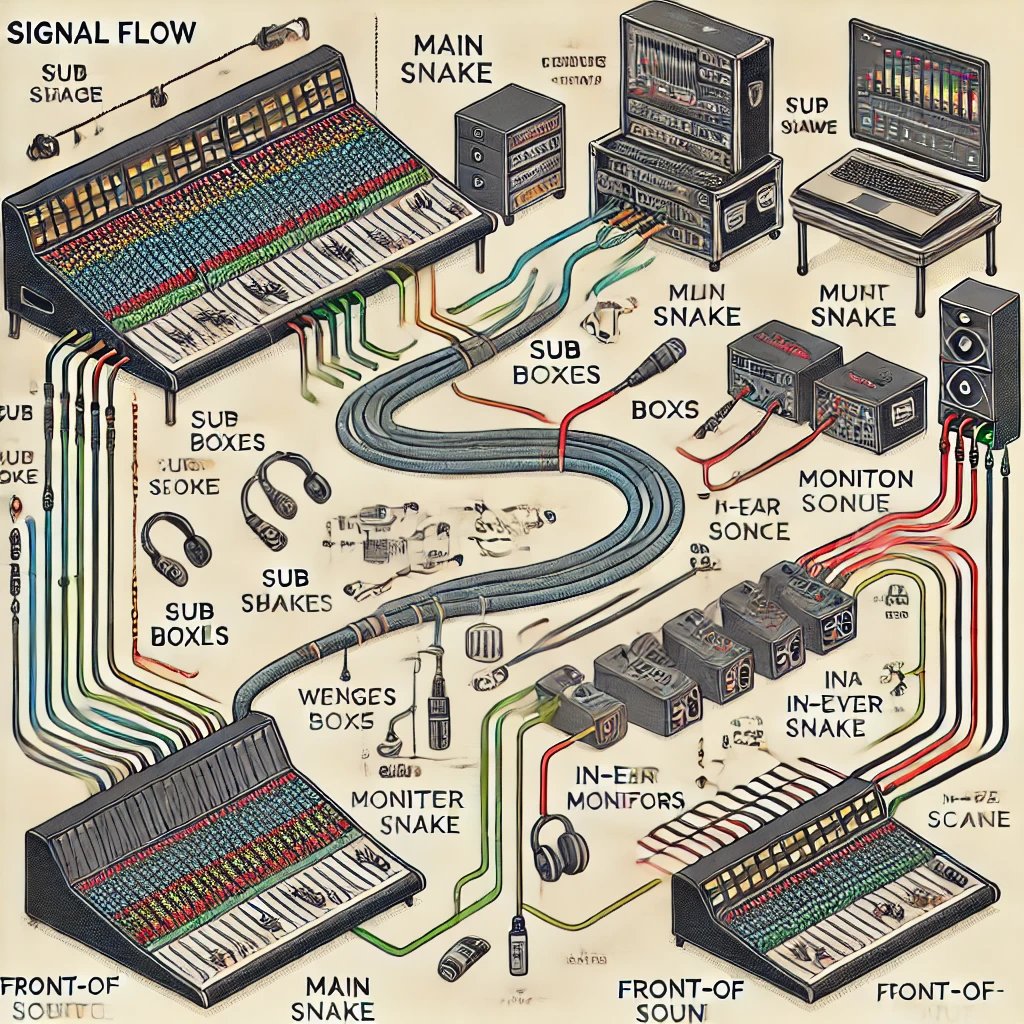Understanding Signal Flow in Live Sound: Basics for Beginners
In the world of live sound engineering, signal flow is one of the most fundamental concepts you need to master. Whether you’re just starting out or looking to deepen your understanding, this guide aims to clarify the basics and walk you through the essential components of a typical live sound system.


What is Signal Flow?
At its core, signal flow is about managing sources and destinations. Sources are the microphones, DI boxes, synthesizers, and laptops that send sound into the system. As an audio engineer, whether you're at the front of house or monitor position, your role is to manage these sources, route them correctly, and ensure they reach the right destinations, such as speakers, in-ear monitors, or recording devices.
From Stage to Mixing Consoles: The Path of the Signal
Let’s break down the signal flow, starting from the stage:
Sub Snakes: On stage, microphones and instruments are connected to sub snakes, which are smaller cables that gather inputs from different parts of the stage. Sub snakes typically come in sizes of 6, 12, or 16 channels, allowing for tidy cable management.
Main Snake: Sub snakes feed into a main snake, which then sends the signals to mixing consoles. This main snake can have both XLR inputs and multi-pin connectors like mass connectors or Ram latch connectors. This setup allows for flexibility depending on the size and complexity of the event.
Splitter Snake: Many larger systems also include a splitter snake, which takes the signals from the stage and splits them for both front of house and monitor consoles. This is where transformer isolation comes into play, ensuring that different engineers receive clean signals without interference.
Front of House vs. Monitor World:
The monitor engineer deals with the mix that artists hear on stage, ensuring they get the specific sound they need to perform. Monitor mixes are usually sent to wedges (floor speakers) or in-ear monitors (IEMs).
The front of house engineer controls the sound that the audience hears, working with the main PA system to ensure a balanced and impactful sound in the venue.
Monitors: The Artist’s Sound Experience
Monitor mixing can be one of the most rewarding and challenging parts of live sound. You’re responsible for making sure the artists hear exactly what they need to perform their best. This involves sending different mixes to various destinations:
Wedges: Floor speakers that project sound directly to the performers.
In-Ear Monitors (IEMs): Wireless or wired systems that deliver the mix directly to the artists’ ears.
Properly setting gain structure is crucial when working with monitors, especially for IEMs. You need to ensure that the output levels from the console are calibrated to avoid clipping the input of the transmitter or IEM receiver.
Front of House: Bringing the Performance to the Audience
The front of house position is all about managing the main PA system. The signal flow is typically:
Console → Signal Processing (DSP) → Amplifiers → Speakers.
In larger systems, the PA is often broken into zones, with matrix outputs used to control different areas, such as main hangs, outfills, delay towers, and front fills. This allows the engineer to adjust the sound for each section of the audience, ensuring that everyone has a great listening experience, no matter where they are seated.
The Importance of Signal Processing and Gain Structure
In both the monitor and front of house systems, digital signal processors (DSP) play a crucial role. They handle tasks like EQ, limiting, and crossover settings. Understanding how these components affect the overall sound is critical to achieving a great mix.
For example, incorrectly setting crossovers can lead to phase issues between the speakers, while improper gain staging can cause distortion or weak sound. Even in a digital world, where much of this is handled internally, knowing how each piece of the signal chain works is essential for troubleshooting and optimizing your sound.
Troubleshooting and Signal Flow Mastery
When something goes wrong during a live show, knowing your signal flow can be a lifesaver. Being able to trace the signal from the source (microphones or instruments) to the destination (speakers or monitors) will help you identify the problem quickly and keep the show running smoothly.
Conclusion
Understanding signal flow is a vital skill for anyone working in live sound. As you gain more experience, you’ll encounter larger systems with more complexity, but the principles remain the same: manage your sources, direct the signals to their appropriate destinations, and maintain a clean and balanced signal throughout the system. Whether you're mixing monitors for the band or controlling the front of house for the audience, mastering signal flow will set the foundation for delivering great sound.
